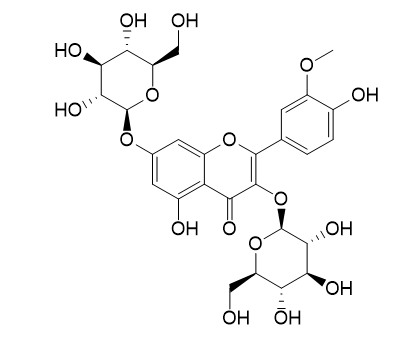Isorhamnetin 3,7-O-diglucoside
Isorhamnetin 3,7-O-diglucoside may have antioxidant activity.
Inquire / Order:
manager@chemfaces.com
Technical Inquiries:
service@chemfaces.com
Tel:
+86-27-84237783
Fax:
+86-27-84254680
Address:
1 Building, No. 83, CheCheng Rd., Wuhan Economic and Technological Development Zone, Wuhan, Hubei 430056, PRC
Providing storage is as stated on the product vial and the vial is kept tightly sealed, the product can be stored for up to
24 months(2-8C).
Wherever possible, you should prepare and use solutions on the same day. However, if you need to make up stock solutions in advance, we recommend that you store the solution as aliquots in tightly sealed vials at -20C. Generally, these will be useable for up to two weeks. Before use, and prior to opening the vial we recommend that you allow your product to equilibrate to room temperature for at least 1 hour.
Need more advice on solubility, usage and handling? Please email to: service@chemfaces.com
The packaging of the product may have turned upside down during transportation, resulting in the natural compounds adhering to the neck or cap of the vial. take the vial out of its packaging and gently shake to let the compounds fall to the bottom of the vial. for liquid products, centrifuge at 200-500 RPM to gather the liquid at the bottom of the vial. try to avoid loss or contamination during handling.
Food Funct.2024, 15(4):1852-1866.
Saudi Pharmaceutical Journal2023, 31(12):101829
J Korean Society of Food Science & Nutrition2021, 50(9): 962-970
Antimicrob Agents Chemother.2020, AAC.01921-20.
Front Nutr.2024, 11:1409309.
Nutrients.2020, 12(12):3607.
bioRxiv - Biochemistry2023, 548213.
Sci Rep.2017, 7:40345
Ann Transl Med.2019, 7(23):731
Food Chem.2019, 275:746-753
Related and Featured Products
Rapid Commun Mass Spectrom. 2010 Jul 30;24(14):2009-22.
Identification of complex, naturally occurring flavonoid glycosides in kale (Brassica oleracea var. sabellica) by high-performance liquid chromatography diode-array detection/electrospray ionization multi-stage mass spectrometry.[Pubmed:
20552580]
The phenolic compounds and organic acids of turnip (Brassica rapa var. rapa L.) edible parts (leaves and stems, flower buds and roots) were determined by HPLC–DAD and HPLC–UV, respectively.
METHODS AND RESULTS:
The results revealed a profile composed of 14 phenolics (3-p-coumaroylquinic, caffeic, ferulic and sinapic acids, kaempferol 3-O-sophoroside-7-O-glucoside, kaempferol 3-O-sophoroside-7-O-sophoroside, kaempferol 3-O-(feruloyl/caffeoyl)-sophoroside-7-O-glucoside, kaempferol 3,7-O-diglucoside,
Isorhamnetin 3,7-O-diglucoside, kaempferol 3-O-sophoroside, 1,2-disinapoylgentiobiose, 1,2′-disinapoyl-2-feruloylgentiobiose, kaempferol 3-O-glucoside and isorhamnetin 3-O-glucoside) and six organic acids (aconitic, citric, ketoglutaric, malic, shikimic and fumaric acids).
CONCLUSIONS:
The quantification of the identified compounds showed kaempferol 3-O-sophoroside-7-O-glucoside, kaempferol 3-O-(feruloyl/caffeoyl)-sophoroside-7-O-glucoside, Isorhamnetin 3,7-O-diglucoside and isorhamnetin 3-O-glucoside as the main phenolics, and malic acid as the organic acid present in highest amounts. A screening of the antioxidative potential was also performed by means of the DPPH radical scavenging assay. Turnip flower buds exhibited the strongest antioxidant capacity.



